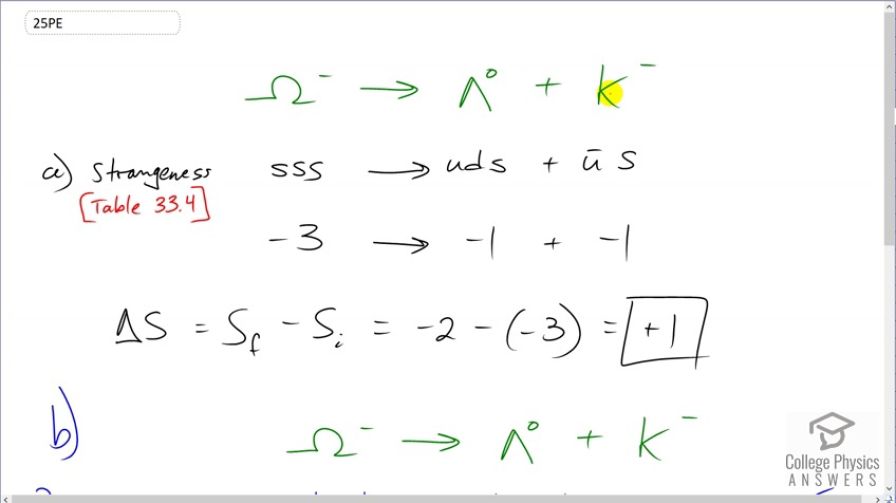Question
One of the decay modes of the omega minus is
- What is the change in strangeness?
- Verify that baryon number and charge are conserved, while lepton numbers are unaffected.
- Write the equation in terms of the constituent quarks, indicating that the weak force is responsible.
Final Answer
- +1
- Please see the solution video
- . Since the conservation of quark flavor is violated, the weak force must be involved.
Solution video
OpenStax College Physics, Chapter 33, Problem 25 (Problems & Exercises)

vote with a rating of
votes with an average rating of
.
Video Transcript
This is College Physics Answers with Shaun Dychko. The omega minus particle turns into the neutral lambda particle plus the negative kappa particle. And there's a change in strangeness because the omega minus particle is made up of three strange quarks each of which has a strangeness of minus 1 so it's a total of minus 3 strangeness in this single particle here. And on the product side, we have the neutral lambda particle has one strange quark so that has a strangeness of minus 1. And the kappa minus particle also has 1 strange quark for a strangeness of minus 1 so it's a total of minus 2 on the product side. So a change in strangeness is the final strangeness minus the initial strangeness so that's minus two final minus the negative 3 to begin with for a total change of plus 1 so it went from minus 3 to minus 2 so the change is plus 1 in strangeness. Now we are going to check that the baryon number and charge are conserved. So each strange quark in the omega minus particle has a baryon number of one-third so that's a total of 1 is the baryon number. And on the right hand side, we have an up, down and strange quark each of which has a baryon number of positive one-third for a total of one here and the kappa minus particle has an anti-down quark which has a baryon number of negative one-third and a strange quark which has a baryon number of positive of a third for a total of zero baryon number in the kappa minus and so the baryon number is positive one on the left and and a total of positive one on the right and yes it's conserved. As for charge, we have a negative one charge in the omega minus, no charge in the lambda zero and then a negative one in the kappa minus particle so that is also conserved. Leptons are neither created nor destroyed in this reaction; you don't see any leptons written here and so lepton number is unchanged. We are going to show the same decay using quark and we'll see that the weak force is involved because we have three strange quarks to begin with turning into only two strange quarks in the end and so that means one strange quark turned into a different type of quark and that violation of the conservation of quark flavor can only be done by the weak force.